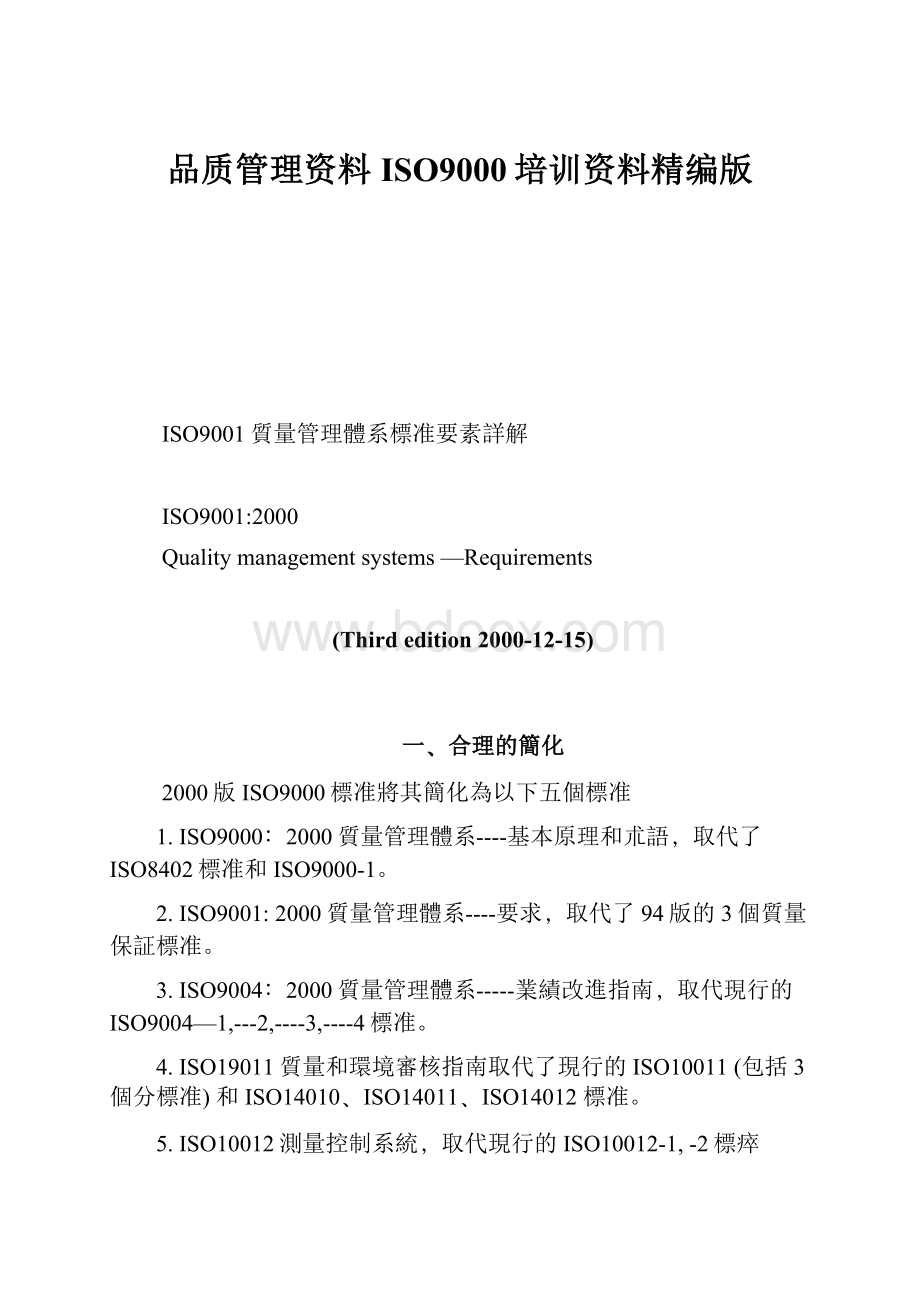品质管理资料ISO9000培训资料精编版.docx
《品质管理资料ISO9000培训资料精编版.docx》由会员分享,可在线阅读,更多相关《品质管理资料ISO9000培训资料精编版.docx(43页珍藏版)》请在冰豆网上搜索。

品质管理资料ISO9000培训资料精编版
ISO9001質量管理體系標准要素詳解
ISO9001:
2000
Qualitymanagementsystems—Requirements
(Thirdedition2000-12-15)
一﹑合理的簡化
2000版ISO9000標准將其簡化為以下五個標准
1.ISO9000﹕2000質量管理體系----基本原理和朮語﹐取代了ISO8402標准和ISO9000-1。
2.ISO9001:
2000質量管理體系----要求﹐取代了94版的3個質量保証標准。
3.ISO9004﹕2000質量管理體系-----業績改進指南﹐取代現行的ISO9004—1,---2,----3,----4標准。
4.ISO19011質量和環境審核指南取代了現行的ISO10011(包括3個分標准)和ISO14010﹑ISO14011﹑ISO14012標准。
5.ISO10012測量控制系統﹐取代現行的ISO10012-1,-2標瘁
94版的ISO9001有20個要素﹐現改為4個部份﹐相互新聞系如下圖﹕
ISO9001:
2000
ISO9001:
1994
1.適用範圍
1
1.1一般規定
1.2Application應用
2.參考標準
2
3.朮語及定義
3
4.品質管理系統
4.1一般要求
4.2.1
4.2文件要求
4.2.2
4.2.1概述
4.5.2+4.5.3
4.2.2品質手冊
4.2.1
4.2.3文件的管制
4.5.1+4.5.2+4.5.3
4.2.4品質記錄的管制
4.16
5.管理責任
5.1管理承諾
4.1+4.1.2.2+4.2.1
5.2以顧客為中心
4.3.2
5.3品質政策
4.1.1
5.4規劃
5.4.1品質目標
4.1.1+4.2.1
5.4.2品質管理系統規劃
4.2.3
5.5責任、職權、溝通
5.5.1責任與職權
4.1.2.1
5.5.2管理代表
4.1.2.3
5.5.3內部溝通
5.6管理審查
4.1.3
5.6.1概述
4.1.3
5.6.2審查輸入
4.1.3
5.6.3審查輸出
4.1.3
6資源管理
6.1資源的提供
4.1.2.2
6.2人力資源
6.2.1概述
4.1.2.2+4.2.3+4.18
6.2.2培訓意識和能力
4.18
6.3資源結構
4.1.2.2+4.9
6.4工作環境
4.9
7產品實現
7.1產品實現的規劃
4.2.3+4.9+4.10.1
7.2客戶相關流程
7.2.1產品有關需求的決定
4.3.2+4.4.4
7.2.2產品有關需求的審查
4.3.2+4.3.3+4.3.4
7.2.3客戶溝通
4.3.2
7.3設計與開發
7.3.1設計與開發規劃
4.4.2+4.4.3+4.4.6+4.4.7+4.4.8
7.3.2設計與開發輸入
4.4.4
7.3.3設計與開發輸出
4.4.5
7.3.4設計與開發審查
4.4.6
7.3.5設計與開發驗證
4.4.7
7.3.6設計與開發確認
4.4.8
7.3.7設計的管制與開發變更
4.4.9
7.4採購
7.4.1採購過程
4.6.1+4.6.2
7.4.2採購資訊
4.6.3
7.4.3採購產品的驗證
4.6.4+4.10.2+4.10.3+4.10.4
7.5生產及服務作業
7.5.1生產與服務准許備管制
4.9+4.10.3+4.15.6+4.19
7.5.2過程的確認
4.9
7.5.3鑑別與追溯
4.8+4.10.5+4.12
7.5.4客戶產品
4.7
7.5.5產品的保存
4.15.2+4.15.3+4.15.4+4.15.5+4.15.6
7.6量測與監控儀器的管制
4.11.1+4.11.2
8量測、分析及改善
8.1概括
4.10+4.20.1
8.2量測與監控
8.2.1客戶滿意
8.2.2內部稽核
4.17
8.2.3流程的監控與量測
4.9+4.20.1
8.2.4產品的量測與監控
4.10.2+4.10.3+4.10.4+4.10.5+4.20
8.3不合格品的管制
4.13.1+4.13.2
8.4資料分析
4.14.2+4.14.3+4.20
8.5改善
8.5.1持續改善之規劃
4.1.3
8.5.2矯正措施
4.14.1+4.14.2
8.5.3預防措施
4.14.1+4.14.3
二﹑詞語的使用更加准確或符合組織的習慣
1.用“質量管理體系”取代了“質量保証體系”﹔
2.用“文件控制”取代了“文件和資料控制”﹔
3.用“顧客的財產”取代了“顧客提供的產品”﹔
4.供應鏈由﹕“承包方------供方-------顧客”改為﹕“供方-----組織------顧客”﹔
5.用“最高管理者”取代“負有執行職責的管理者”。
三﹑更方便地適用于各種產品類型和規模的組織
1.以過程模式代替20個要素的模式。
將20個要素的形式變成四部分﹐這種結構具有普遍的適用性。
但其并不強求組
織更改其質量管理體系的結構或其文件﹐以和本國際標准的結構保持一致﹐組織
的質量管理體系文件的規定應適合于其特有的活動方式。
2.強調根據組織的具體情況設計適用的質量管理體系。
文件的要求有了較大的靈活性﹐
a.標准要求必須建立程序文件的共有6處﹕
文件控制
記錄控制
內部審核
不合格品控制
糾正措施
預防措施
b.別一類的組織要求的文件﹐主要指產品實現過程所需的文件。
四﹑標准要求
NOTEInaddition,themethodologyknownas“Plan-Do-Check-Act”(PDCA)canbeappliedtoallprocesses.PDCAcanbebrieflydescribedasfollows.
Plan:
establishtheobjectivesandprocessesnecessarytodeliverresultsinaccordancewithcustomerrequirementsandtheorganization'spolicies.
Do:
implementtheprocesses.
Check:
monitorandmeasureprocessesandproductagainstpolicies,objectivesandrequirementsfortheproductandreporttheresults.
Act:
takeactionstocontinuallyimproveprocessperformance.
Figure1—Modelofaprocess-basedqualitymanagementsystem
Qualitymanagementsystems—Requirements
1Scope
范圍
1.1General
總則
ThisInternationalStandardspecifiesrequirementsforaqualitymanagementsystemwhereanorganization
本國際標准規定的質量管理體系要求組織﹕
a)needstodemonstrateitsabilitytoconsistentlyprovideproductthatmeetscustomerandapplicable
regulatoryrequirements,and
需証實其持續提供符合客戶需求及適用法規要求產品的能力。
b)aimstoenhancecustomersatisfactionthroughtheeffectiveapplicationofthesystem,including
processesforcontinualimprovementofthesystemandtheassuranceofconformitytocustomerand
applicableregulatoryrequirements.
目的在于通過系統的有效運作以達到客戶的滿意﹐包括持續改善系統的流程和確保符合客戶滿及適用
法規的需求。
NOTEInthisInternationalStandard,theterm“product”appliesonlytotheproductintendedfor,orrequiredby,acustomer.
備注﹕在本國際標准中﹐述語’產品’指的是客戶訂購或客戶需求的產品。
1.2Application
應用
AllrequirementsofthisInternationalStandardaregenericandareintendedtobeapplicabletoallorganizations,regardlessoftype,sizeandproductprovided.
本國際標准規定的是一般和通用的要求﹐適用于所有組織﹐不論其類型﹑規模和提供的產品如何。
Whereanyrequirement(s)ofthisInternationalStandardcannotbeappliedduetothenatureofanorganizationanditsproduct,thiscanbeconsideredforexclusion.
本國際標准的要求會因組織或產品的特性因素而不適用﹐可以考慮排除。
Whereexclusionsaremade,claimsofconformitytothisInternationalStandardarenotacceptableunlesstheseexclusionsarelimitedtorequirementswithinclause7,andsuchexclusionsdonotaffecttheorganization'sability,orresponsibility,toprovideproductthatmeetscustomerandapplicableregulatoryrequirements.
組織可以排除的條款僅限于條款7中的要求﹐并且僅可以排除不影響組織提供符合客戶和適用的法律要求的產品的能力和責任的要求。
否則就不能聲稱符合本國際標准。
2Normativereference
引用標准
Thefollowingnormativedocumentcontainsprovisionswhich,throughreferenceinthistext,constituteprovisionsofthisInternationalStandard.Fordatedreferences,subsequentamendmentsto,orrevisionsof,anyofthesepublicationsdonotapply.However,partiestoagreementsbasedonthisInternationalStandardareencouragedtoinvestigatethepossibilityofapplyingthemostrecenteditionofthenormativedocumentindicatedbelow.Forundatedreferences,thelatesteditionofthenormativedocumentreferredtoapplies.MembersofISOandIECmaintainregistersofcurrentlyvalidInternationalStandards.
下列相關國際標准所包含條文﹐通過在本標准中引用而構成為本標准的條文﹐由于引用的條文會逐漸過時﹑陸續修正或改版﹐造成引用的國際標准不再適用。
然而﹐使用本國際標准的各方應探討使用下列相關國際標准之最新版本的可能性。
IEC和ISO成員都持有現行有效的國際標准。
ISO9000:
2000,Qualitymanagementsystems—Fundamentalsandvocabulary.
ISO9000:
2000質量管理體系-基礎知識和朮語
3Termsanddefinitions
朮語和定義
ForthepurposesofthisInternationalStandard,thetermsanddefinitionsgiveninISO9000apply.
出于本國際標准的目的﹐使用的朮語和定議在ISO9000中給出。
Thefollowingterms,usedinthiseditionofISO9001todescribethesupplychain,havebeenchangedtoreflectthevocabularycurrentlyused:
在ISO9001﹕2000描述供應鏈所使用的朮語被改變為組織普遍使用的詞匯﹕
Supplierorganizationcustomer
供方組織客戶
Theterm“organization”replacestheterm“supplier”usedinISO9001:
1994,andreferstotheunittowhichthisInternationalStandardapplies.Also,theterm“supplier”nowreplacestheterm“subcontractor”.
朮語’組織’取代了ISO9001:
1994版使用的朮語’供方’,意思是適用于本國際標准的單位。
同樣用朮語供方取代了朮語分供方。
ThroughoutthetextofthisInternationalStandard,wherevertheterm“product”occurs,itcanalsomean“service”.
在整個標准中所使用的朮語’產品’在這里同樣包括’服務’。
4Qualitymanagementsystem
質量管理體系
4.1Generalrequirements
一般要求
Theorganizationshallestablish,document,implementandmaintainaqualitymanagementsystemandcontinuallyimproveitseffectivenessinaccordancewiththerequirementsofthisInternationalStandard.
組織應建立﹑執行并保持一個文件化的質量管理體系﹐并持續改進其有效性使其與本國標標准要求相一至。
Theorganizationshall
組織應
a)identifytheprocessesneededforthequalitymanagementsystemandtheirapplicationthroughoutthe
organization(see1.2),
認別實施質量管理系統及應用于整個組織所需的流程。
b)determinethesequenceandinteractionoftheseprocesses,
確定這些流程之順序及相互關系。
c)determinecriteriaandmethodsneededtoensurethatboththeoperationandcontroloftheseprocesses
areeffective,
確定所需標准及方法﹐以確保這些流程可達成有效作業及管制。
d)ensuretheavailabilityofresourcesandinformationnecessarytosupporttheoperationandmonitoringof
theseprocesses,
提供有效的資源和資訊﹐以支持這些流程的運行及管制。
e)monitor,measureandanalysetheseprocesses,and
監控﹑測量及分析這些流程。
f)implementactionsnecessarytoachieveplannedresultsandcontinualimprovementoftheseprocesses.
執行所需要的活動﹐來達成計划并持續改進這些流程。
TheseprocessesshallbemanagedbytheorganizationinaccordancewiththerequirementsofthisInternationalStandard.
組織應對這些流程進行管理使其與本國際標准的要求相一至。
Whereanorganizationchoosestooutsourceanyprocessthataffectsproductconformitywithrequirements,theorganizationshallensurecontroloversuchprocesses.Controlofsuchoutsourcedprocessesshallbeidentifiedwithinthequalitymanagementsystem.
當組織遷擇會影響到產品符合要求的外部流程時﹐組織應確保這些外部流程得到控制﹐并在質量管理體系中對這些流程進行鑒別。
NOTEProcessesneededforthequalitymanagementsystemreferredtoaboveshouldincludeprocessesformanagementactivities,provisionofresources,productrealizationandmeasurement.
備注﹕在上面所述的質量管理所需的流程包括管理活動﹑資源提供﹑產品實現及測量流程。
4.2Documentationrequirements
文件需求
4.2.1General
一般要求
Thequalitymanagementsystemdocumentationshallinclude
質量管理體系文件應包括﹕
a)documentedstatementsofaqualitypolicyandqualityobjectives,
文件化的質量方針和質量目標。
b)aqualitymanual,
質量手冊。
c)documentedproceduresrequiredbythisInternationalStandard,
本國際標准要求的程序文件。
d)documentsneededbytheorganizationtoensuretheeffectiveplanning,operationandcontrolofits
processes,and
組織需求的確保流程得到有效的實施和控制的文件。
e)recordsrequiredbythisInternationalStandard(see4.2.4).
本國際標准要求的記錄。
(見行條款4.2.4)
NOTE1Wheretheterm“documentedprocedure”appearswithinthisInternationalStandard,thismeansthattheprocedureisestablished,documented,implementedandmaintained.
備注1﹕要本國際標准中出現的朮語’文件化程序’﹐是要求建立﹑形成文件﹑實施程序并予以保持。
NOTE2Theextentofthequalitymanagementsystemdocumentationcandifferfromoneorganizationtoanotherdueto
備注2﹕品質管理體系文件的范圍可能因以下原因在組織間會有差異﹕
a)thesizeoforganizationandtypeofactivities,
組織的規模和類型。
b)thecomplexityofprocessesandtheirinteractions,and
流程的復雜程度和相互作用。
c)thecompetenceofpersonnel.
人員的能力。
NOTE3Thedocumentationcanbeinanyformortypeofmedium.
備注3﹕文件化的程序和文件可存在任何形式的媒體。
4.2.2Qualitymanual
質量手冊
Theorganizationshallestablishandmaintainaqualitymanualthatincludes
組織就建立并保持個質量手冊﹐包含以下內容﹕
a)thescopeofthequalitymanagementsystem,includingdetailsofandjustificationforanyexclusions(see
1.2),
質量管理體系的范圍﹐包括詳細內容及任何排除情況和原因。
b)thedocumentedproceduresestablishedforthequalitymanagementsystem,orreferencetothem,and
質量管理體系建立的文件化程序或其援引。
c)adescriptionoftheinteractionbetweentheprocessesofthe